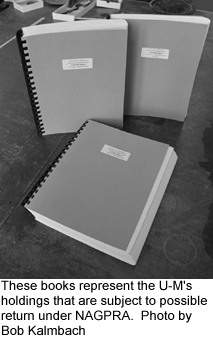The University Record, May 20, 1997
U documenting NAGPRA items that
may have to be returned
By Jane R. Elgass
 It took more than five years and an army of workers, but the University has completed cataloging hundreds of artifacts and remains to comply with the Native American Graves Protection and Repatriation Act (NAGPRA).
It took more than five years and an army of workers, but the University has completed cataloging hundreds of artifacts and remains to comply with the Native American Graves Protection and Repatriation Act (NAGPRA).
The 1990 federal law, applied to all institutions that receive federal funds, calls for a return of items from grave sites to Native American tribes that request them and can prove cultural affiliation with the items. The U-M will make the first transfer of some items early this summer.
For years, scholars have felt that the evidence of the past, being destroyed by farming and other types of land development, would be safe in museums, says John O’Shea, professor of anthropology and director and curator of the Museum of Anthropology. Enactment of NAGPRA was a blow to that philosophy, O’Shea says.
In 1992, the University committed to an initial investment of $350,000 for cataloging holdings owned by the U-M, gathered over the years from 465 sites, about half of them in Michigan. Some of the collections were developed by U-M researchers, some were gifts, and others were purchased. To date, the cataloging price tag is nearly $500,000.
Sacred objects and those related to a tribe’s cultural patrimony are among the most likely to be subject to repatriation, O’Shea says. Among the factors involved in identifying items subject to return are determining what the item is; who found it, when and where; how it was transferred to the University; whether the item is “culturally affiliated”; and whether the item is something that one would exclusively find in a grave.
“It’s really a good faith effort on our part,” O’Shea says. Many of the items date to before European contact, and the link to a currently recognized tribe is sometimes difficult to make.
O’Shea briefed the Regents at their April meeting on the status of the University’s efforts so far. Now work is focused on documenting as thoroughly as possible those items that are likely to be returned, so the University can retain some of the scientific value.
The University began notifying tribes of its holdings in 1993, well ahead of the 1995 federal deadline. Work with the tribes is in an open-ended phase, with the University supplying information to the tribes and conducting negotiations for the return of items. A list of the U-M’s holdings is on the Web, which O’Shea says has been the entry point for many inquiries. There is no deadline for the tribes or other groups that may make claims to respond.
There have been “numerous requests but there is no major rush,” O’Shea says, and several tribes have deferred. “This is a very complex issue for Native American groups.”
Other faculty members involved in the massive project include John D. Speth, Arthur F. Thurnau Professor, professor of anthropology and also a curator at the Museum who focuses on North American collections in general; Richard I. Ford, professor of anthropology and of botany and a Museum curator who specializes in ethnographic collections; and C. Loring Brace, professor of anthropology and curator of human osteology who focuses on human osteology—the study of the structure and function of bones. O’Shea specializes in Great Lakes area research.

